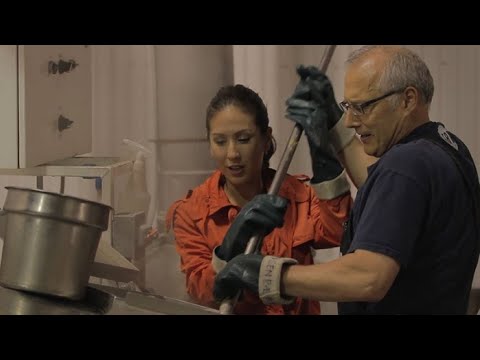Career Overview
Chemical technologists and technicians provide technical support and services or may work independently in chemical engineering, chemical and biochemical research and analysis, industrial chemistry, chemical quality control and environmental protection.
People in this occupation:
- Are employed by research and development and quality control laboratories, consulting engineering companies, in chemical, petrochemical, pharmaceutical and a variety of other manufacturing and processing industries, and by utilities and health, education and government establishments
- Should have a strong background in chemistry, physics and math
- Should have the ability to draw conclusions from data and communicate technical information clearly
- Should also be patient and persistent and have a good eye for detail
- Must have problem-solving skills
Duties
Chemical technologists:
- Set up and conduct chemical experiments, tests and analyses using techniques such as chromatography, spectroscopy, physical and chemical separation techniques and microscopy
- Operate and maintain laboratory equipment and apparatus and prepare solutions of gas or liquid, reagents, and sample formulations
- Compile records and interpret experimental or analytical results
- Develop and conduct programs of sampling and analysis to maintain quality standards of raw materials, chemical intermediates and products
- Assist in the development of chemical engineering processes, studies of chemical engineering procurement, construction, inspection and maintenance and the development of standards, procedures and health and safety measures
- Operate experimental chemical or petrochemical pilot plants
- Conduct or assist in air and water quality testing and assessments, environmental monitoring and protection activities, and development of and compliance with standards
- Assist in synthesis of small molecules for the purpose of creating drug candidates
- Assist in the design and fabrication of experimental apparatus.
Chemical technicians:
- Assist in setting up and conducting chemical experiments, tests and analyses
- Operate and maintain laboratory equipment and apparatus and prepare solutions of gas and liquid, reagents and sample formulations
- Compile records for analytical studies
- Assist in developing and conducting programs of sampling and analysis to maintain quality standards
- Carry out a limited range of other technical functions in support of chemical research, tests and analyses, and environmental air and water quality monitoring and protection
- Assist in the design and fabrication of experimental apparatus
Special duties
Chemical technologists and technicians generally specialize in an area such as analytical chemistry, production of industrial chemicals, materials science, food technology, mineral processing, pulp and paper technology, recycling technology, industrial chemistry or environmental monitoring and protection.
Earnings
Earnings is income that workers receive in exchange for their labour. Depending on the type of employment, earnings can be in the form of wages (hourly), salaries (fixed monthly or annual) or self-employed earnings.
Work Environment
# Workers Employed
830% Employed Full Time
69%Chemical technologists and technicians generally work 35 to 40 hours per week, however, evening and weekend shifts may be required to meet deadlines. Most work is performed indoors in labs or processing plants, although outdoor work may be necessary to take environmental samples and conduct site inspections.
Chemical technologists and technicians may work alone or as part of a team. Workers are often required to stand for extended periods of time and may be exposed to odours, toxic fumes and other hazardous substances, so workers follow safety procedures in order to limit risks.
Career Pathways
Chemical technologists and technicians may progress to managerial positions (i.e., supervisors, managers, project managers) with experience. There is also a lot of mobility among the different jobs in this occupational group.
Related Careers
Occupational Interests
It’s important to understand what kinds of occupations align with your interests.
For more about occupational interests visit Skills for the Future Workforce > Characteristics.
Here are the top occupational interest(s) for this career profile:
Job Titles
Education, Training and Skills
Chemical technologists and chemical technicians are usually required to have completed a one to three-year college program in chemical, biochemical or chemical engineering technology or a related discipline. However, some chemical technologists and technicians working in chemistry or biochemistry research are university graduates.
Professional certification for chemical technologists and technicians is available through the Applied Science Technologists and Technicians of B.C. (ASTTBC). Completion of an accredited diploma program and two years of industry work experience are required for an Applied Science Technologist (AScT) designation and completion of an accredited certificate program and two years of industry work experience are required for Certified Technician (CTech) designation.
Certification with ASTTBC is transferable between provinces. For more information, please visit the ASTTBC website at www.asttbc.org.
Certification for chemical technologists is also available through the Canadian Society for Chemical Technology (CSCT). Designation as a Certified Chemical Technologist (cCt) normally requires graduation from an accredited program and at least two years of industry work experience. For more information, please visit the CSCT website at: http://www.cheminst.ca/about/csct.
Education programs in B.C.
The following program areas are related to this occupation:
- Food Sciences/Technology
- Plastics Technology
- Biotechnology

Skills
Every job calls for a certain set of skills. Knowing those skills is the first step in finding a good career fit.
Here, you will find the 10 most relevant workplace skills. Some are more important to achieving success in a certain career than others. These skills may come naturally to you or you may need to gain them through education, training and experience.
See the list of work-related skills below, ranked in order of importance for this career. Check out the list and see if this career matches your skills—take that first step!
Giving full attention to what other people are saying, taking time to understand the points being made, asking questions as appropriate, and not interrupting at inappropriate times.
Understanding written sentences and paragraphs in work-related documents.
Using logic and reasoning to identify the strengths and weaknesses of alternative solutions, conclusions or approaches to problems.
Talking to others to share information effectively.
Keeping track of and assessing your performance, other individuals, or organizations to make improvements or take corrective action.
Communicating effectively in writing as appropriate for the needs of the audience.
Using scientific rules and methods to solve problems.
Being able to solve novel, ill-defined problems in complex, real-world settings.
Considering the relative costs and benefits of potential actions to choose the most appropriate one.
Watching gauges, dials or other indicators to make sure that a machine is working properly.
Labour Market Statistics
Discover data, facts and information that have been gathered and analyzed. Learn about the characteristics of the economy and labour market in B.C.
Employment
Find out about employment types and trends by region and industry.
Employment
830Employment by Region















| Region | Employment | % Employment of this Occupation |
|---|---|---|
| Cariboo | 15 | 1.8% |
| Kootenay | 30 | 3.6% |
| Mainland/Southwest | 630 | 76.4% |
| North Coast and Nechako | 0 | 0.0% |
| Northeast | 15 | 1.8% |
| Thompson-Okanagan | 75 | 9.1% |
| Vancouver Island/Coast | 60 | 7.3% |
Labour Market Outlook
The B.C. Labour Market Outlook is a 10-year forecast of the expected supply and demand for labour in the province. It’s usually updated every year. The purpose is to provide British Columbians with the knowledge to make informed decisions on careers, skills training, education and hiring.
Forecasted Job Openings (2023-2033)
360Forecasted Job Openings
Forecasted Employment Growth Rate
Composition of Job Openings
Job Openings by Region (2023-2033)















| Region | Job Openings | Avg. Annual Employment Growth |
|---|---|---|
| Cariboo | Not available | Not available |
| Kootenay | 20 | 1.3% |
| Mainland/Southwest | 290 | 1.2% |
| North Coast and Nechako | Not available | Not available |
| Northeast | Not available | Not available |
| Thompson-Okanagan | 20 | -0.1% |
| Vancouver Island/Coast | 30 | 1.7% |
Industry Highlights
Learn about the opportunities in B.C.'s major industries, including employment trends, earning potential, locations of work and more.
Forecasted Job Openings by Industry
| Industry | Job Openings (2023-2033) |
|---|---|
| Professional, Scientific And Technical Services | 160 |
| Manufacturing | 120 |
| Retail Trade | 20 |
| Educational Services | 10 |
| Public Administration | 10 |
Insights from Industry
The majority of the jobs that will become available will come from the need to replace workers who retire. However, there is currently strong demand in this industry for skilled technical professionals in this occupation.
The largest employer of chemical technologists and technicians in B.C. is the Manufacturing industry. Within this industry, Rubber, plastics and chemicals manufacturing will likely see growth in the future. Pulp and paper manufacturing may experience further consolidation as older mills are phased out and newer, state-of-the-art mills remain. This could limit demand for workers in this sector, although prospects could change if more pulp mills are retrofitted for the production of specialty chemicals, bioenergy and biofuels.
Demand for workers in the Professional business services industry is tied to a wide variety of other industries, such as the resource sector, manufacturing, real estate development and health care services. Employment growth in this industry is expected to follow overall growth in the provincial economy. Demand for workers in the Rubber, plastics and chemicals industry will likely see growth in the future.
An area of employment growth for these workers is environmental services. The growing prominence of environmental issues for federal, provincial and municipal government agencies will create employment opportunities in monitoring and regulatory services that involve chemical sampling and analysis.
Improvements in automation technology may somewhat reduce the demand for chemical technologists and technicians. Basic instrumentation skills are increasingly required in order to maintain and troubleshoot these pieces of equipment.
Resources
-
Applied Science Technologists and Technicians of BC – Careersasttbc.org/public/tech-jobs
-
Canadian Association of Geophysical Contractors (CAGC)www.cagc.ca
-
Canadian Association of Oilwell Drilling Contractors (CAODC)caodc.ca
-
Canadian Council of Technicians and Technologists (CCTT)www.cctt.ca
-
Canadian Gas Association (CGA)www.cga.ca
-
Canadian Institute of Mining, Metallurgy and Petroleum (CIM)www.cim.org
-
Canadian Society for Chemical Technology (CSCT)www.cheminst.ca/about/cic
-
Careers in Oil + Gaswww.careersinoilandgas.com
-
Chemical Institute of Canada (CIC)www.cheminst.ca
-
Energy Safety Canadawww.energysafetycanada.com/
-
Engineers Canadawww.engineerscanada.ca
-
Explorers and Producers Association of Canada (EPAC)explorersandproducers.ca
-
Independent Contractors and Businesses Association (ICBA)www.icba.ca
-
National Energy Board (NEB)www.neb-one.gc.ca/index-eng.html
-
Petroleum Services Association of Canada (PSAC)www.psac.ca
-
Prospectors and Developers Association of Canada (PDAC)www.pdac.ca









